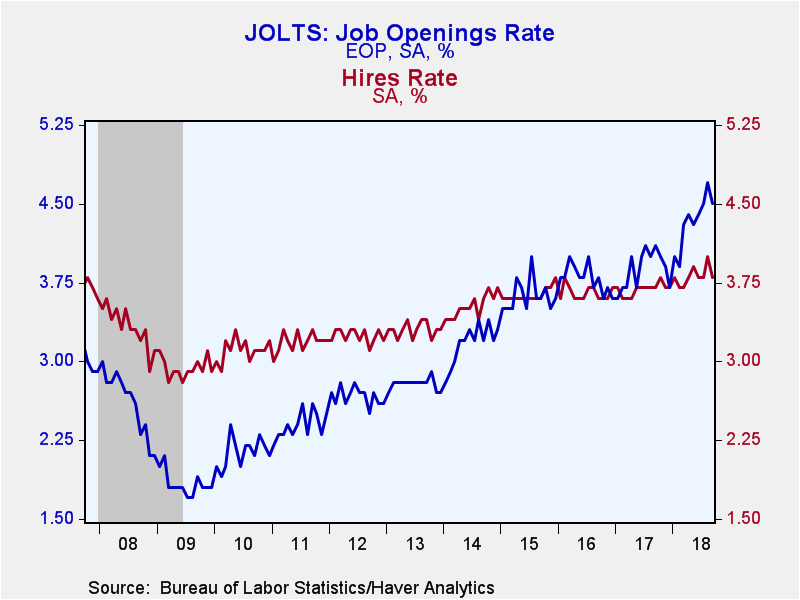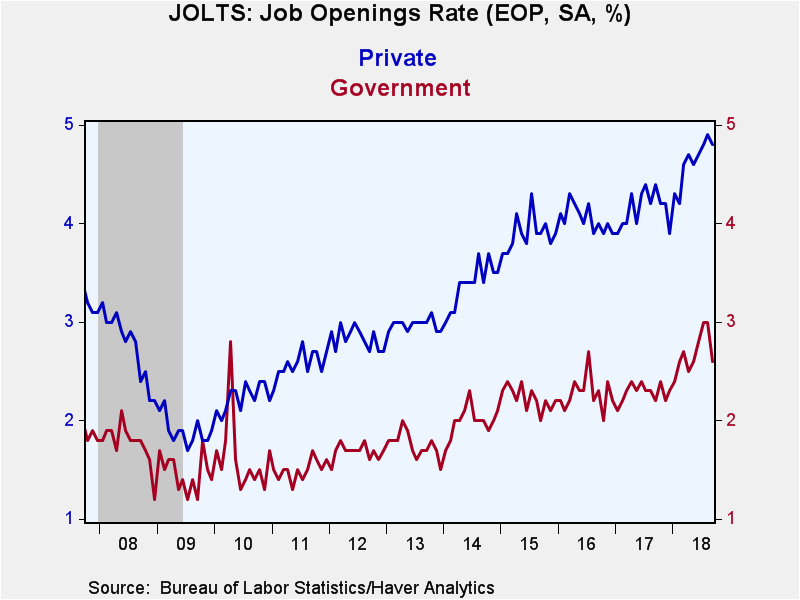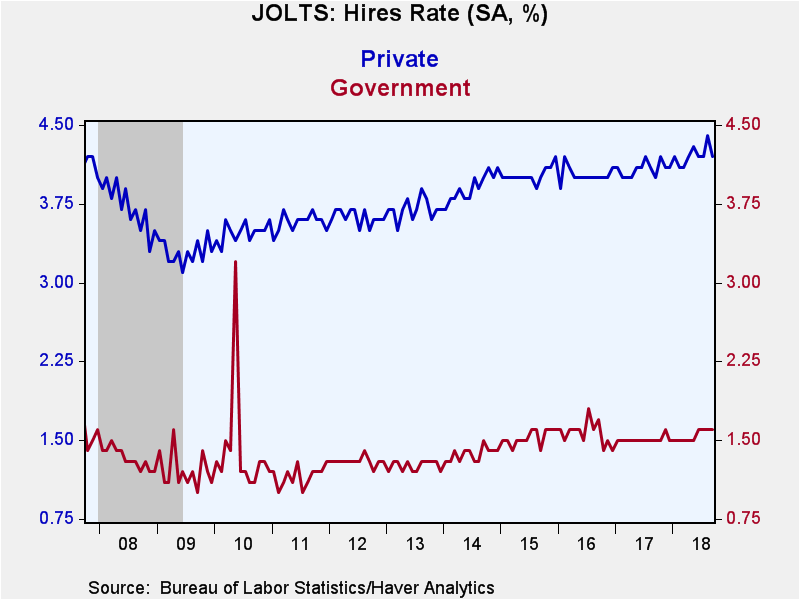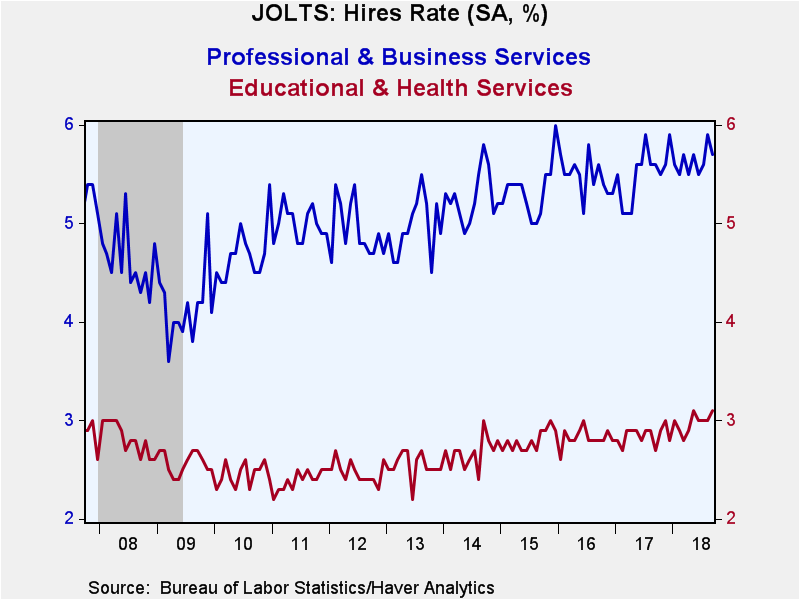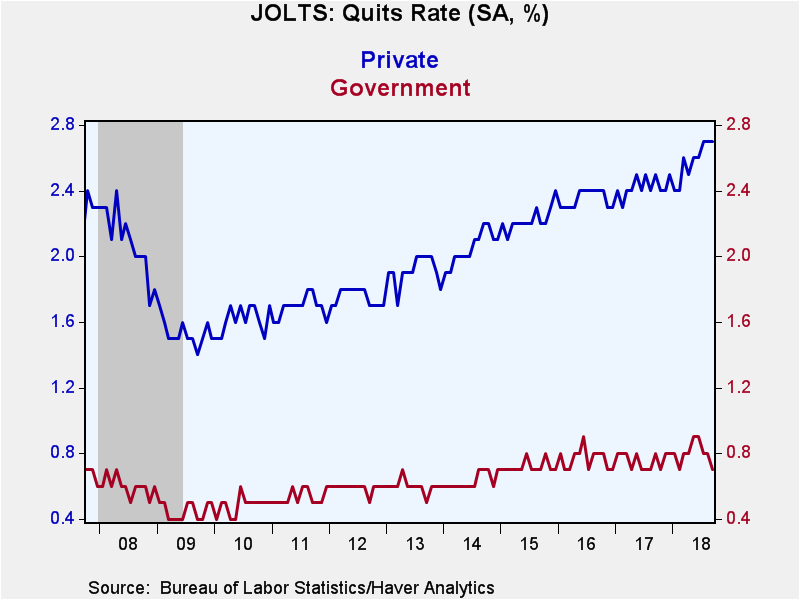 Global| Nov 06 2018
Global| Nov 06 2018U.S. JOLTS: Job Openings Rate Backs Away From Record
by:Tom Moeller
|in:Economy in Brief
Summary
The Bureau of Labor Statistics reported that the total job openings rate fell to 4.5% in September from the record of 4.7% in August, revised from 4.6%. The job openings rate is the job openings level as a percent of total employment [...]
The Bureau of Labor Statistics reported that the total job openings rate fell to 4.5% in September from the record of 4.7% in August, revised from 4.6%. The job openings rate is the job openings level as a percent of total employment plus the job openings level. The hiring rate slipped to 3.8% from 4.0%, revised from 3.9%, but remained up from the recession low of 2.8% in 2009. The layoff & discharge rate slipped to 1.1%, nearly the record low, and the quits rate held at 2.4% for the third month, just below the record high. The JOLTS data begin in 2000.
The private-sector job openings rate eased to 4.8% from the record 4.9%. Leisure & hospitality strengthened to a series high of 6.0%, while professional & business services eased to 5.6% from the three-year high of 6.1%. In education & health services, the share increased to a near record 5.2%, while in construction, it slipped to a still strong 3.7%. The rate in manufacturing slipped to a firm 3.7% and in trade, transportation & utilities, it held steady a 4.4%. The job openings rate in government declined sharply to 2.6%, but remained up sharply versus the 2009 low of 1.2%.
The level of job openings declined 3.9% (+12.5% y/y) to 7.009 million and reversed the August rise to a record 7.293 million. Private-sector openings slipped m/m but remained up 11.9% y/y. Construction sector job availability surged by one-half y/y. Openings in leisure & hospitality strengthened by one-third y/y and they rose 15.7% y/y in education & health services. Trade, transportation & utilities job openings increased 11.7% y/y. Factory sector openings rose 8.8% y/y while openings in professional business services gained a reduced 2.8% y/y. Government sector job openings increased a lessened 19.7% y/y.
The private-sector hiring rate fell to 4.2% in September from August's eleven-year high of 4.4%. The rate in leisure & hospitality improved to 6.6%, but in professional & business services, it slipped to 5.7%. The construction sector's hiring rate held firm at 5.1%. The hiring rate in trade, transportation & utilities declined to 4.2% after surging to a 12-year high of 4.4% in August. In education & health services, the rate gained to 3.1%, but in manufacturing it fell sharply to 2.6%, a 12-month low. The hiring rate in government held steady at 1.6%.
Total hiring declined 2.7% (+6.9% y/y) to 5.744 million and reversed the August gain. Hiring in the private sector increased 7.2% y/y with educational & health services surging 14.3% y/y. Trade, transportation & utilities hiring strengthened 11.4% and leisure & hospitality improved 8.1% y/y. Professional & business employment increased 2.9% y/y, but factory-sector hiring declined 1.2% y/y. Construction sector jobs also fell 3.4% y/y.
The overall job separations rate eased to 3.8% from an upwardly revised 3.9% in August, but remained near its twelve-year high. The private sector separations rate fell to 4.2% from its cycle high of 4.3%. The separations rate in government slipped to 1.5%.
The level of overall separations strengthened 6.0% y/y to 5.667 million. In the private sector, they were up 6.7% y/y led by a 17.1 y/y surge in trade, transportation & utilities and a 13.8% y/y rise in educational & health services. In the financial sector, they jumped 10.8%. Separations increased 6.1% y/y in leisure & hospitality, while in professional & business services, they edged up 1.5% y/y. Meanwhile, construction separations fell 9.4% y/y and education & health services inched down 0.3% y/y. Separations in the factory sector eased 0.9% y/y, while in the information sector they declined 17.2% y/y. Separations in the government sector gained 8.0% y/y.
The level of quits edged down 1.3% m/m (+10.6% y/y) to 3.601 million in September while the quits rate held steady at July's record of 2.4%. The private-sector quit rate also was unchanged at 2.7%. The rate fell sharply in the financial sector to 1.4% and in professional & business services the rate held steady at 3.3%. The government sector quit rate eased to 0.7%.
The level of layoffs declined 3.6% to 1.700 million, lowering the layoff rate to 1.1%, nearly the record low. In the private sector, the layoff rate held steady at 1.3%. The professional & business services rate fell to 1.9%, while in the factory sector, it eased to 0.7%. The government sector layoff rate slipped to 0.5%.
The Job Openings & Labor Turnover Survey (JOLTS) survey dates to December 2000 and the figures are available in Haver's USECON database.
| JOLTS (Job Openings & Labor Turnover Survey, SA) | Sep | Aug | Jul | Sep'17 | Sep'16 | Sep'15 |
|---|---|---|---|---|---|---|
| Job Openings, Total | ||||||
| Rate (%) | 4.5 | 4.7 | 4.5 | 4.1 | 3.8 | 3.6 |
| Total (000s) | 7,009 | 7,293 | 7,077 | 6,229 | 5,650 | 5,367 |
| Hires, Total | ||||||
| Rate (%) | 3.8 | 4.0 | 3.8 | 3.7 | 3.6 | 3.6 |
| Total (000s) | 5,744 | 5,906 | 5,713 | 5,375 | 5,255 | 5,147 |
| Layoffs & Discharges, Total | ||||||
| Rate (%) | 1.1 | 1.2 | 1.1 | 1.2 | 1.1 | 1.3 |
| Total (000s) | 1,700 | 1,790 | 1,622 | 1,764 | 1,527 | 1,879 |
| Quits, Total | ||||||
| Rate (%) | 2.4 | 2.4 | 2.4 | 2.2 | 2.1 | 2.0 |
| Total (000s) | 3,601 | 3,648 | 3,608 | 3,173 | 3,161 | 2,926 |
Tom Moeller
AuthorMore in Author Profile »Prior to joining Haver Analytics in 2000, Mr. Moeller worked as the Economist at Chancellor Capital Management from 1985 to 1999. There, he developed comprehensive economic forecasts and interpreted economic data for equity and fixed income portfolio managers. Also at Chancellor, Mr. Moeller worked as an equity analyst and was responsible for researching and rating companies in the economically sensitive automobile and housing industries for investment in Chancellor’s equity portfolio. Prior to joining Chancellor, Mr. Moeller was an Economist at Citibank from 1979 to 1984. He also analyzed pricing behavior in the metals industry for the Council on Wage and Price Stability in Washington, D.C. In 1999, Mr. Moeller received the award for most accurate forecast from the Forecasters' Club of New York. From 1990 to 1992 he was President of the New York Association for Business Economists. Mr. Moeller earned an M.B.A. in Finance from Fordham University, where he graduated in 1987. He holds a Bachelor of Arts in Economics from George Washington University.


